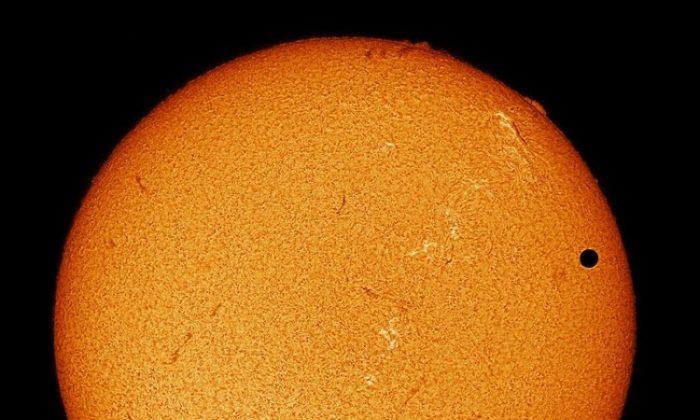The live feeds have ended. See photos and videos here.
A once-in-a-lifetime event will take place on June 5 or 6 (depending on the location of viewers) when Venus will be visible as a tiny black dot moving across the sun. The next Venus transit isn’t due until 2117.
A transit of Venus occurs when the sun, Venus, and Earth line up in a perfect row, allowing observers on Earth to see the planet’s silhouette. It will be visible in most of the world except Antarctica, most of South America, and roughly half of Africa, according to NASA’s predictions.
Venus will take about six hours to cross the sun, starting at 10:09 p.m. GMT (6:09 p.m. EDT, 3:09 p.m. PDT).
Residents in latitudes above approximately 67 degrees north; in Alaska, Korea, Japan, the Philippines, Papua New Guinea, and New Zealand; and most of Australia, China, and Russia will be able to see the whole transit.
Most of North America, Central America, and the northwestern part of South America will see the beginning of the transit before sunset on June 5, while parts of Africa, Europe, Asia, and Australia will see the end of the transit after sunrise on June 6.
Since it’s not safe to look directly at the sun, the transit must be viewed with a safe solar viewing device or projection method. You may use the eclipse shades left over from the May 20 eclipse, but Venus will look very small without magnification.
Alternatively, use a pair of binoculars to focus a larger image of the sun onto a piece of white paper. Without looking through them, line the binoculars up so that sunlight comes out of the eyepieces.
[video]http://www.youtube.com/watch?v=68Lve169iiQ[/video]
With magnified viewing methods, you can see the “black-drop effect”—a black band will seem to connect Venus to the sun’s edge for about a minute as it starts to transit. The effect is thought to be associated with Venus’s or Earth’s atmosphere, or due to the viewing apparatus used.
Astronomer Jay Pasachoff from Williams College in Massachusetts will be watching the phenomenon closely with his colleagues. By observing any changes in Venus’s atmosphere, they can test methods for gleaning information from watching transits in other solar systems.
“Doing so verifies that the techniques for studying events on and around other stars hold true in our own backyard,” said Pasachoff, writing in May’s issue of Physics World.
“In other words, by looking up close at transits in our solar system, we may be able to see subtle effects that can help exoplanet hunters explain what they are seeing when they view distant suns.”
Meanwhile, French astronomers plan to watch the event with the moon as a mirror, using the Hubble Space Telescope to observe how the moon darkens during the transit.
Later this year, Pasachoff and team will use Hubble to observe Venus transiting the sun from Jupiter, which will happen on Sept. 20. Then on Dec. 21, they will watch it from Saturn, using Cassini, the NASA spacecraft orbiting the ringed planet.
“We are fortunate in that we are truly living in a golden period of planetary transits and it is one of which I hope astronomers can take full advantage,” Pasachoff concluded.
Here on Earth, transits of Venus come in pairs eight years apart, and there is more than a century between each pair. The last Venus transit was in 2004, and the previous pair took place in 1874 and 1882.
The live feeds have ended. See photos and videos here.
The Epoch Times publishes in 35 countries and in 19 languages. Subscribe to our e-newsletter.








